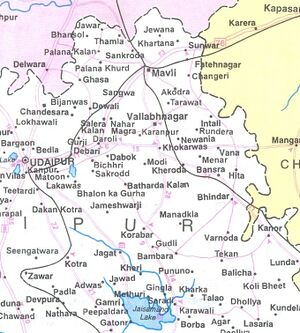Balathal
| Author: Laxman Burdak IFS (R) |
Balathal (बालाथल) is a village in Vallabhnagar tahsil (noe Bhindar tahsil) of Udaipur District in Rajasthan.
Contents
Location
The Balathal (24º 43' N; 73 º 59' E) archaeological site, located 6 km from Vallabhnagar town and 42 km from Udaipur city insouth-east. Balathal Pin code is 313601
Origin
History
Balathal is an archaeological site located in Vallabhnagar tehsil of Udaipur district of Rajasthan state in western India. It is one of the ninety Ahar-culture sites located in the Basins of the Banas river and its tributaries. The excavations at Balathal produced evidence as to the origin of the early farming community of Central India and brought about traces of early urbanization.
Excavation
The archaeological site, located 6 km from Vallabhnagar town and 42 km from Udaipur city. It was discovered by V. N. Misra during a survey in 1962-63. It was excavated from 1994 to 2000, jointly by the Department of Archaeology of the Deccan College Post-graduate and Research Institute, Pune and the Institute of Rajasthan Studies, Rajasthan Vidyapeeth, Udaipur under the direction of V. N. Misra of the Deccan College.[1] Balathal is one of the important sites in Mewar region of Rajasthan. The extensive excavations carried out at the site have produced vast amounts of data.
There were various ethnobotanical remains recovered at Balathal and these include wheat, barley, Indian jujube, okra, and Job's tears as well as several varieties of millet, lentils, and peas.[2] The excavated remains also included domesticated animals such as sheep, goat, and cattle. Archaeologists also discovered several burial sites where the earliest evidence of leprosy in South Asia was found. This was identified in the remains of an adult male buried sometime between 2500 and 2000 B.C.[3]
Balathal was occupied during two cultural periods: the Chalcolithic and the Early Historic.
Chalcolithic phase: Chalcolithic Period (3000-1500 B.C.), also referred to as the Ahar culture is characterized partially by its well-planned structures. For example, buildings had multiple rooms, with structures servings varying functions.[4] Evidence from this era that was found includes clay, stone, shell, and copper objects, as well as floral and animal remains. Some of the pottery from Balathal was locally produced, while other types found at Balathal came from other sites in the Ahar-Banas Complex. This, and other, evidence show that the chalcolithic communities traded and exchanged materials with other contemporary communities, which may have included settlements like Harappan in Gujarat.[5]
Available data suggest that Balathal was a well-fortified settlement and underwent a period of economic development and then a decline.[6] This decline entailed a decrease in population and corresponded with the rise of a contemporary Harappan (Indus) civilization.
Early Historic phase: After the Chalcolithic phase, Balathal was abandoned for a long time until the Early Historic phase (500-200 B.C.) of the site’s activity. It was discovered that there was a cultural vacuum that persisted from five to six centuries. This new settlement already had the knowledge of iron, which enabled the inhabitants to establish agriculture practice and production. The excavated artifacts, which included tools such as plows, sickles, knives, spades, hoes, and adzes, among others, revealed that the settlement already produced crops twice a year.[7]
बालाथल
बालाथल एक ऐतिहासिक ग्राम जो उदयपुर (राजस्थान) नगर से 42 किमी दक्षिण-पूर्व में वल्लभ नगर तहसील में बालाथल स्थित है। बालाथल ग्राम के पूर्वी छोर पर एक बड़ा टीला है जो लगभग 5 एकड़ क्षेत्र में फैला हुआ है। इस टीले में उत्खनन का कार्य 1993 में वी. एन. मिश्रा के नेतृत्व में हुआ। यहाँ से हड़प्पा संस्कृति के समान ही मृदभाण्ड पाए गए हैं। अतः अनुमान है कि हड़प्पा के लोगों से इनका निकट सम्पर्क रहा होगा। इस क्षेत्र के लोगों ने पत्थर और मिट्टी की ईंटों के बड़े-बड़े मकान बनवा लिए थे। भारत के अन्य ताम्रपाषाणयुगीन स्थलों पर केवल मिट्टी के छोटे मकानों के ही प्रमाण मिले हैं। यहाँ से परिष्कृत मृद्भाण्डों में प्यालियाँ और कटोरियाँ हैं। यहाँ से परवर्ती हड़प्पायुगीन लोहे के औजार भी प्रभूत मात्रा में पाये गये हैं। लोहा गलाने की भट्टियाँ भी प्राप्त हुई हैं। पुरातत्त्ववेत्ताओं ने बालाथल की ताम्रपाषाणयुगीन सभ्यता के मध्य भाग का समय 2350 ई. पू. के आसपास माना है। यदि यह मान लिया जाए तो ऐसा लगता है कि 2700 ई.पू. आस-पास बालाथल में ताम्रपाषाणुयगीन लोगों ने स्थिर जीवन शैली अपना ली होगी।[8]
Population
Notable Persons
External Links
References
- ↑ Shinde, Vasant; Raczek, Teresa; Possehl, Gregory (2014). Excavations at Gilund: The Artifacts and Other Studies. University of Pennsylvania Press. p. 5. ISBN 9781934536667.
- ↑ Shinde, Vasant; Raczek, Teresa; Possehl, Gregory (2014). Excavations at Gilund: The Artifacts and Other Studies. University of Pennsylvania Press. p. 5. ISBN 9781934536667.
- ↑ Shinde, Vasant; Raczek, Teresa; Possehl, Gregory (2014). Excavations at Gilund: The Artifacts and Other Studies. University of Pennsylvania Press. p. 5. ISBN 9781934536667.
- ↑ Srivastava, Vinod Chandra (2008). History of Agriculture in India, Up to C. 1200 A.D. New Delhi: Concept Publishing Company. p. 344. ISBN 9788180695216.
- ↑ Thorpe, Edgar; Thorpe, Showick (2010). The Pearson CSAT Manual 2011. Delhi: Pearson. ISBN 9788131758304.
- ↑ Shinde, Vasant; Raczek, Teresa; Possehl, Gregory (2014). Excavations at Gilund: The Artifacts and Other Studies. University of Pennsylvania Press. p. 5. ISBN 9781934536667.
- ↑ Srivastava, Vinod Chandra (2008). History of Agriculture in India, Up to C. 1200 A.D. New Delhi: Concept Publishing Company. p. 344. ISBN 9788180695216.
- ↑ भारतकोश-बालाथल
